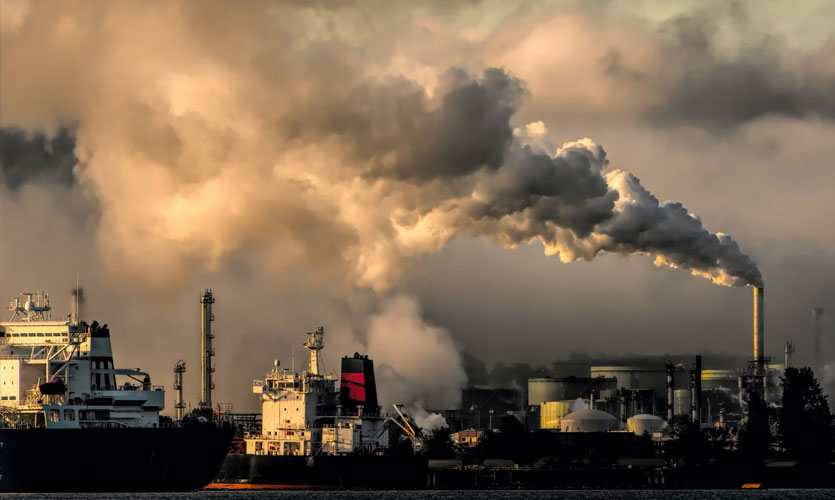According to the Intergovernmental Panel on Climate Change (IPCC), a peak in greenhouse gas emissions must be reached by 2025. This needs to be followed by a 43 percent reduction over the next ten years, to limit global warming to 1.5°C by 2100. The IPCC has called for immediate action and warned that policies implemented until the end of 2020 will increase emissions, and could lead to a 3.2°C rise by the end of the century.
Working Group III of the IPCC, the preeminent body of environmental experts from around the world, released its report to assess the status of efforts and what has to be done to prevent a climate crisis. Many experts believe that current practices have already resulted in irreversible and devastating effects.
Despite repeated warnings from the IPCC, about the looming dangers of dangerous global warming, it appears that the time for limiting it is running out. In the report, it warned that annual GHG emissions in the past decade were higher than those in any previous decade: emissions between 2010-19 were around 12 percent and 54 percent higher than those in 2010 and 1990, respectively. However, the report says that the growth rate of GHG emissions has slowed in recent years.
Some of the findings are particularly relevant to India. For instance, depleting the carbon budget to keep global warming under 1.5°C, increasing financing for energy transition, and the IPCC’s call to move away from fossil fuels. Therefore, India has a very small amount of carbon budget left to grow.
In terms of global financial flows from developed countries, they are between three and six times lower than those needed to meet the Paris Agreement goal of limiting global warming to 2°C, by 2030. The IPCC, however, argues that there is sufficient global liquidity and capital to close the investment gap. The report said that governments need to signal their commitment to transitioning to a low carbon economy in order to gain access to global capital.
By 2030, the remaining carbon budget needed to keep global warming to 1.5°C will likely have been exhausted by global CO2 emissions.
Scaling up mitigation will be critical in the coming years, according to Navroz Dubash, professor at the Centre for Policy Research, and coordinating lead author of the IPCC report. He maintains that the focus should now be on “limiting damage and doing as much as we can in (the) short-run”.
Reports have shown that greenhouse gas emissions in 2030, based on the implementation of national determined contributions (NDCs) announced before COP 26 last year, are unlikely to limit global warming to 1.5°C.
“The jury has reached a verdict… And it is damning. This report of the Intergovernmental Panel on Climate Change is a litany of broken climate promises. It is a file of shame, cataloguing the empty pledges that put us firmly on track towards an unlivable world. We are on a fast track to climate disaster: Major cities under water. Unprecedented heat waves. Terrifying storms. Widespread water shortages. The extinction of a million species of plants and animals. This is not fiction or exaggeration,” said UN Secretary-General António Guterres during the launch of the report.
“It is what science tells us will result from our current energy policies. We are on a pathway to global warming of more than double the 1.5-degree limit agreed in Paris,” he added.
In spite of these negatives, there are a few positives in the report. The report found that the costs of solar and wind energy, and batteries, have decreased by up to 85 percent since 2010. Additionally, there has been an increase in the number of electric vehicles (EVs).
According to the report, a range of policies and laws have enhanced energy efficiency, reduced deforestation rates, and increased the use of renewable energy. Reductions in carbon dioxide emissions across the entire energy sector will require major transitions, including a substantial decrease in fossil fuel use. The installation of fossil fuel infrastructure will continue unabated, locking in greenhouse gas emissions.
For India, it is essential to convey messages on cheaper renewable energy and moving away from fossil fuels.
Prime Minister Narendra Modi, at the Glasgow climate summit on November 1 last year, announced that India’s non-fossil energy capacity would reach 500 GW by 2030, providing 50 percent of the country’s energy needs. India plans to reduce its total projected carbon emissions by one billion tonnes and reduce the carbon intensity of its economy by 45 percent by 2030, and achieve net-zero emissions by 2070.
In Glasgow, PM Modi also warned that such ambitious action would not be possible without adequate climate finance from developed nations, urging developed countries to make $1 trillion available as climate finance “as soon as possible”. The coal ministry said in the Rajya Sabha last week that an energy transition away from coal is not expected in the near future in India, although the government will promote renewable energy.
In the report’s chapter ‘Policy and Institutions’, Dubash provides an outline of the policies that nations like India might adopt, such as establishing institutions or commissions to supervise energy transition and mitigatio,n and propose climate laws to assure its implementation.
“Having the right policies, infrastructure and technology in place to enable changes to our lifestyles and behaviour can result in a 40-70% reduction in greenhouse gas emissions by 2050. This offers significant untapped potential,” said IPCC Working Group III co-chair Priyadarshi Shukla, in an IPCC statement, on Monday.
The IPCC has emphasised the importance of cities and urban regions in reducing emissions. These can be done through reducing energy use (for example, by designing small, walkable cities), electrifying transportation, and combining low-emission energy sources.
According to Arunabha Ghosh, CEO of the Council on Energy, Environment, and Water, the current IPCC report serves as a stern warning to all industrialised countries to accelerate their transition to a net-zero economy. As stated by Ghosh, this will help nations such as India achieve their development goals while remaining on pace to fulfil their net-zero aim. Furthermore, wealthier countries should facilitate increased investment and knowledge transfer in critical industries such as renewables, electric vehicles, green hydrogen, and others, in order to accelerate the global low-carbon transition. Ghosh maintained that failure to limit global warming to 1.5°C would likely create irreversible harm to our ecosystems, which will disproportionately decimate the economies and vulnerable populations in the global south.
While recognising that the global carbon budget to meet the 1.5°C goal is now almost exhausted, the IPCC report has underlined that countries at all stages of economic development seek to improve the well-being of people, and their development priorities reflect different starting points and contexts, which should be considered.
Read more: Low-lying Countries Urge Immediate Action On Climate Change
Inequalities in emission distribution and the consequences of mitigation measures within nations have an influence on social cohesion, and the acceptability of mitigation and other environmental policies. Equity and fair transitions can permit greater goals for faster mitigation, according to the report.
The chapter on ‘Investment and Funding’ also mentions how poor climate finance flows from affluent countries have hampered energy transformation in underdeveloped countries. “Finance to reduce net GHG emissions and enhance resilience to climate impacts is a critical enabling factor for the low carbon transition. Fundamental inequities in access to finance as well as financial terms and conditions, and countries’ exposure to physical impacts of climate change overall, result in a worsening outlook for a global just transition,” states the report.
The 1.5°C aim is critical as according to the IPCC, limiting the rise by an additional 0.5°C above the previous threshold of 2°C could prevent 420 million people from being exposed to extreme heat waves, lower the risk of heavy rain and extreme drought, and lower the risk of catastrophic flooding.










